
USS Constitution, also known as Old Ironsides, is a three-masted wooden-hulled heavy frigate of the United States Navy. She is the world's oldest ship of any type still afloat. She was launched in 1797, one of six original frigates authorized for construction by the Naval Act of 1794 and the third constructed. The name "Constitution" was among ten names submitted to President George Washington by Secretary of War Timothy Pickering in March of 1795 for the frigates that were to be constructed. Joshua Humphreys designed the frigates to be the young Navy's capital ships, and so Constitution and her sister ships were larger and more heavily armed and built than standard frigates of the period. She was built at Edmund Hartt's shipyard in the North End of Boston, Massachusetts. Her first duties were to provide protection for American merchant shipping during the Quasi-War with France and to defeat the Barbary pirates in the First Barbary War.

The first USS Newark (C-1) was a United States Navy protected cruiser, the eighth protected cruiser launched by the United States. In design, she succeeded the "ABC" cruisers Atlanta, Boston, and Chicago with better protection, higher speed, and a uniform 6-inch gun armament. Four additional protected cruisers were launched for the USN prior to Newark.

The fifth USS Boston was a protected cruiser and one of the first steel warships of the "New Navy" of the 1880s. In some references she is combined with Atlanta as the Atlanta class, in others as the Boston class.

USS Algonquin, completed as El Toro in 1891 for the Southern Pacific Railroad's Morgan Line, was a small harbor tug commissioned by the United States Navy 2 April 1898. Renamed Accomac, after Accomac, Virginia, June 1898, renamed Nottoway in 1918 and, after the Navy adopted alphanumeric hull numbers on 17 July 1920, classified as YT-18, a district tug. On 5 October 1942 the name was cancelled and the tug was simply YT-18 until 1944 when classification was changed to YTL-18, a little harbor tug. Over the years as a Navy tug, from 1898 to 1946, the tug served from Cuba to Boston.

The second USS Marblehead (C-11/PG-27) was a Montgomery-class unprotected cruiser in the United States Navy, authorized in the naval appropriations bill of September 7, 1888. Marblehead served in the Spanish–American War and World War I, and was the last ship of her class in service.
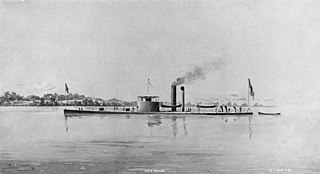
The first Passaic was a single turreted, coastal monitor purchased by the United States Navy for service during the American Civil War.
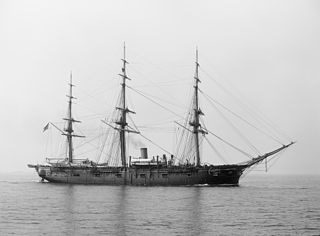
The first USS Lancaster was a screw sloop-of-war in the United States Navy during the American Civil War through the Spanish–American War.

The first USS Jamestown was a sloop-of-war in the United States Navy during the Mexican–American War and the American Civil War.

USS Hawk (PY-2/IX-14) was the converted British-built civilian yacht Hermione of 1891, acquired for service as a patrol yacht in the Spanish–American War. She later served in the Ohio and New York naval militias and on the Great Lakes until decommissioned in 1940.
The fifth USS Congress was a screw sloop in the United States Navy.

The second USS Puritan was a Puritan-class monitor in the United States Navy, constructed in 1882. She was the only ship in her class.

USS Key West (PG-125/PF-17), a Tacoma-class frigate, was the second ship of the United States Navy to be named for Key West, Florida.

USS Detroit (C-10) was a Montgomery-class unprotected cruiser of the United States Navy which was authorized by an Act of Congress in September 1888. Detroit was launched on 28 October 1891 at Columbian Iron Works, Baltimore, Maryland, sponsored by Miss F. Malster. The cruiser was commissioned on 20 July 1893 with Commander Willard Herbert Brownson in command. It was the third ship to be named for Detroit, Michigan.

USS Winslow was a United States Navy torpedo boat noted for its involvement at the First and Second Battle of Cardenas during the Spanish–American War. She was named for Rear Admiral John Ancrum Winslow.
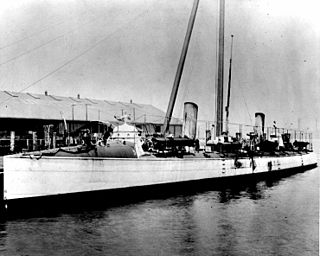
USS Foote was launched 1 October 1896 by Columbian Iron Works and Dry Dock Co., Baltimore, Md.; sponsored by Miss Laura Price; and commissioned 7 August 1897, Lieutenant W. L. Rodgers in command.

The second USS Rodgers was a United States Navy torpedo boat, laid down by the Columbian Iron Works & Dry Dock Co., Baltimore, Maryland, on 6 May 1896; launched on 10 November 1896; and commissioned on 2 April 1898, Lt. Joseph Lee Jayne in command. It was named after John Rodgers as well as John Rodgers.

The first USS MacKenzie, was laid down by Charles Hillman Ship & Engine Building Company, Philadelphia, 15 April 1897; launched 19 February 1898; sponsored by Master Charles Hillman; and commissioned 1 May 1899, Lt. L. H. Chandler in command.

USS Topeka (PG-35) was a gunboat of the United States Navy.
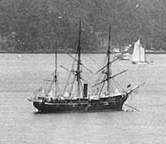
As part of the Secretary of the Navy George M. Robeson's plans to overhaul and modernize ships of the Navy, the first USS Swatara was taken to the New York Navy Yard in 1872, ostensibly for "repairs". In fact, the "repairs" constituted construction of a new ship, for Swatara was given a new hull and unused machinery which had been in storage since 1865. Embodying only certain fittings and equipment from the first ship, the second Swatara was launched on 17 September 1873 at the New York Navy Yard and commissioned on 11 May 1874, Capt. Ralph Chandler in command.
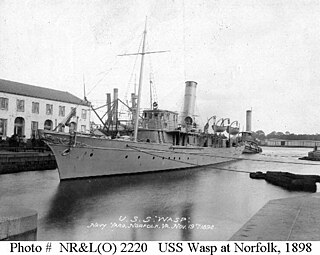
The seventh USS Wasp was the former yacht Columbia, purchased by the U.S. Navy and converted to an armed yacht serving from 1898 to 1919, with service in the Spanish–American War and World War I.


















